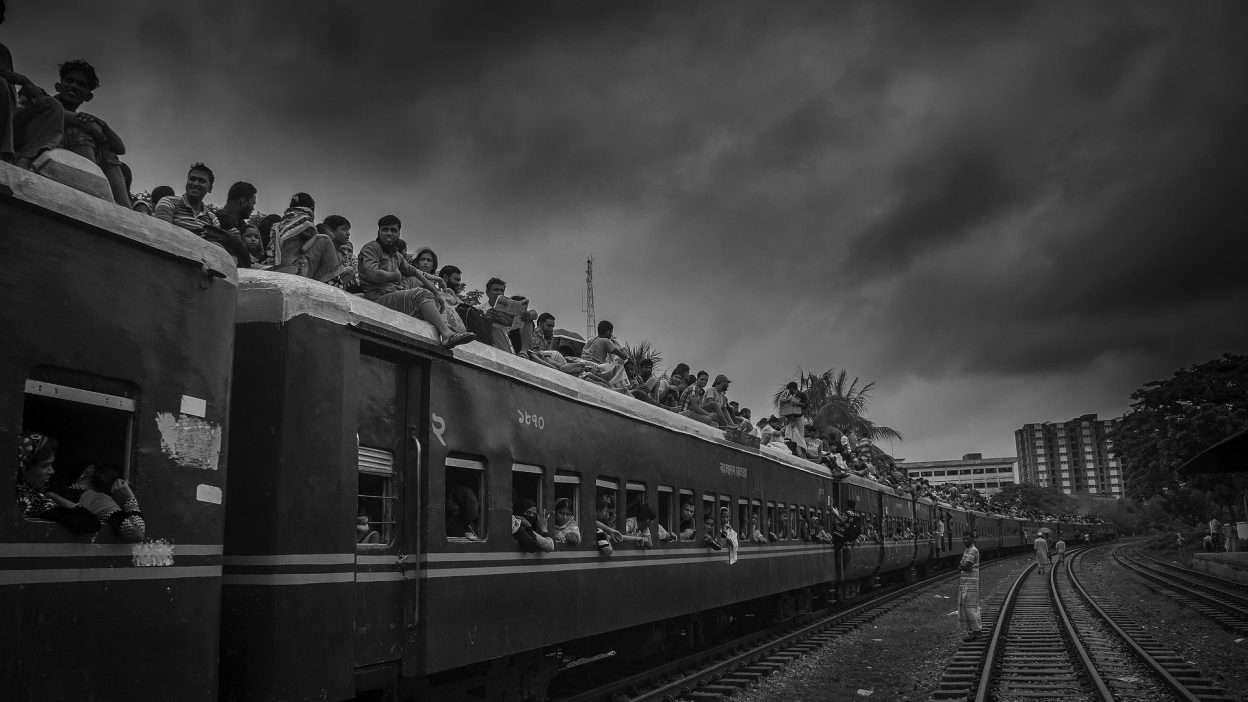The Storm That Annihilated a Village in Minutes
Bangladesh has long been a country battered by natural disasters, from devastating cyclones to catastrophic floods. However, among these tragedies, one event stands out as particularly brutal and unforgettable—the 1973 Dhaka Tornado. Striking on 17 April 1973, this ferocious storm tore through Manikganj, a rural district near Dhaka, leaving hundreds of people dead and thousands homeless in a matter of minutes.
With wind speeds reaching over 330 km/h (205 mph), this intense twister flattened everything in its path—homes, trees, and even human bodies were lifted and thrown like ragdolls. The official death toll was at least 681 people, but many believe the true number was much higher, as entire families were wiped out, leaving no one to report the missing.
This catastrophic event struck a newly independent Bangladesh, still struggling to recover from the 1971 Liberation War. Already dealing with economic hardship and political instability, the young nation found itself facing yet another disaster. This raises a crucial question: Could this disaster have been prevented? And is Bangladesh better prepared today, or are its rural communities still at risk?
1. The Deadliest Tornado in Bangladesh’s History: A Disaster That Came Without Warning
The morning of 17 April 1973 began like any other in Manikganj, with villagers going about their daily routines, completely unaware of the approaching catastrophe. Bangladesh is no stranger to severe storms, but nothing could have prepared these communities for what was about to unfold.
As the afternoon sun blazed down, ominous dark clouds began to gather in the sky. Within moments, violent winds started whipping through the region, escalating rapidly into a full-blown tornado. Witnesses later described the deafening roar of the storm, likening it to the sound of a passing train or an explosion.
The tornado, believed to have been an F4 on the Fujita scale, ripped through the villages of Manikganj at terrifying speeds, demolishing homes and hurling debris across vast distances. In mere minutes, entire families were crushed beneath collapsing buildings, while others were lifted into the air and thrown several kilometres away.
With no early warning systems or tornado shelters, the people of Manikganj had nowhere to run, nowhere to hide. Those who survived had little left—homes, livestock, crops, and entire communities had been obliterated in the blink of an eye.
2. A Country in Crisis: Bangladesh’s Struggle to Recover from War and Disaster
When the 1973 Dhaka Tornado struck, Bangladesh was still reeling from the devastating effects of the 1971 Liberation War. The war had left the country in ruins, with shattered infrastructure, extreme poverty, and a fragile new government struggling to stabilise the nation.
The economy was in shambles, food shortages were widespread, and healthcare facilities were almost non-existent. In the aftermath of the war, millions of people were already displaced, malnourished, and fighting for survival.
The tornado only worsened this suffering, adding thousands more to the list of the homeless and destitute. With the government still in its infancy, there was little to no disaster response in place. Aid was slow to arrive, and the affected communities were left to fend for themselves, relying on whatever little resources they could salvage.
This disaster exposed the harsh reality of Bangladesh’s vulnerability—not just to natural calamities, but also to governmental inefficiency and lack of preparedness. It was a wake-up call, but did the country truly learn from it?
3. The Brutal Aftermath: Death Toll, Injuries, and the Scale of Destruction
- Staggering Death Count – The official death toll from the tornado was 681 people, but many believe the true number was much higher. Entire families vanished, making it impossible to accurately count the missing. The tornado lifted bodies and flung them across kilometres, with some found stuck in trees or buried under debris days later.
- Thousands Maimed and Injured – The storm left thousands of people injured, many suffering from broken bones, severe lacerations, and blunt force trauma. With limited medical facilities, many succumbed to their injuries, unable to receive the help they desperately needed.
- 30,000 Left Without Shelter – The tornado flattened more than 90% of homes in the affected areas. Those that survived the storm found themselves with no roof over their heads, no food, and no water. The majority of survivors lived in temporary shelters for months, struggling to rebuild.
- Economic Devastation – With livestock killed, crops destroyed, and businesses wiped out, the tornado left an already struggling region in even deeper poverty. The affected communities took years to recover, and some never fully did.
- One of the World’s Deadliest Tornadoes – Despite its horrifying destruction, the 1973 Dhaka Tornado is often overlooked in global history. It remains one of the deadliest tornadoes ever recorded, yet it has faded into obscurity outside Bangladesh.
4. What Made This Tornado So Deadly? The Science Behind the Storm
Bangladesh’s location makes it highly prone to tornadoes, but the 1973 Manikganj Tornado was exceptionally fierce. This deadly twister formed when a collision of extreme weather patterns created a perfect storm.
A surge of hot, humid air from the Bay of Bengal met cooler, drier air from the Himalayas, leading to intense atmospheric instability. This set the stage for a supercell thunderstorm, which soon escalated into a violent tornado.
Experts believe the tornado was an F4 or possibly even an F5, with wind speeds exceeding 330 km/h (205 mph). The force of the winds shredded homes, uprooted trees, and even lifted heavy vehicles into the air.
At the time, Bangladesh had no advanced meteorological technology, meaning there were no tornado warnings. Even today, while forecasting has improved, rural communities remain highly vulnerable to sudden, violent tornadoes.
5. The Nightmarish Horror of Survivors: ‘People Were Pulled Into the Sky’
Those who lived through the tornado describe it as something out of a nightmare. Survivors remember a sudden, deafening roar, followed by houses exploding into the sky.
Abdul Majid, a local farmer, recalled: “I saw my neighbour’s house lift off the ground and vanish. We found their bodies 10 kilometres away.”
Another survivor, Razia Begum, spoke of how her family was swept away: “One second we were in our house, and the next, I was outside, bleeding, and my family was gone.”
For weeks after the storm, bodies continued to be found in fields, rivers, and treetops, a grim reminder of the tornado’s brutality.
6. Government Response: Too Little, Too Late?
In the aftermath of the disaster, the Bangladeshi government struggled to provide aid. Relief efforts were slow due to blocked roads, damaged infrastructure, and lack of resources.
Many survivors were left to starve, as food and clean water supplies were critically low. International help was minimal, as Bangladesh was not yet a priority for global aid organisations.
This tragedy highlighted the country’s lack of disaster preparedness, a problem that continues to plague Bangladesh even today.
7. Could This Happen Again? The Risk of Future Tornadoes
- Bangladesh remains a high-risk country for tornadoes
- Many rural areas still lack proper warning systems
- Disaster response has improved, but is still inadequate
- A similar tornado today could still cause massive casualties
8. Lessons Learned: What Did Bangladesh Change After the 1973 Dhaka Tornado?
The 1973 Dhaka Tornado was a wake-up call for Bangladesh, exposing the country’s lack of disaster preparedness and early warning systems. In the years that followed, the government took some steps to improve its response to severe weather events, but the changes were far from enough.
One of the biggest improvements was the development of better meteorological monitoring. Although Bangladesh still lacks high-tech tornado tracking systems, it has made progress in cyclone and storm forecasting. The Bangladesh Meteorological Department (BMD) now provides severe weather alerts, but these systems are still limited in rural areas where tornadoes cause the most damage.
The government has also invested in disaster management policies. The creation of the Cyclone Preparedness Programme (CPP) and the Disaster Management Bureau helped coordinate relief efforts for future storms. However, these initiatives focused more on cyclones than tornadoes, leaving many communities just as vulnerable as they were in 1973.
Perhaps the biggest lesson was the need for stronger infrastructure. The tornado destroyed thousands of homes, exposing how fragile rural buildings were. Since then, stronger housing materials have been promoted, but due to widespread poverty, many still live in weak structures that cannot withstand severe storms.
While Bangladesh has made some progress, experts agree that the country is still unprepared for another tornado of this magnitude. Without better forecasting, stronger infrastructure, and faster emergency response, history could easily repeat itself.
9. Could a Disaster Like the 1973 Dhaka Tornado Happen Again?
The terrifying truth is that Bangladesh remains one of the most tornado-prone countries in the world, and a similar disaster could strike again at any moment.
Despite the advancements in weather forecasting, tornadoes remain extremely difficult to predict. While modern technology has improved storm tracking, Bangladesh still lacks the resources to detect tornadoes early enough to save lives.
The factors that made the 1973 tornado so deadly—high population density, weak housing, and poor disaster preparedness—still exist today. In fact, climate change is making extreme weather even more unpredictable, increasing the risk of more powerful and frequent tornadoes in the future.
If another F4 or F5 tornado were to hit a densely populated area, the death toll could be just as catastrophic—if not worse. Without urgent action, Bangladesh could face another devastating tornado disaster, leaving thousands dead and homeless once again.
10. Conclusion: The 1973 Dhaka Tornado Must Not Be Forgotten
Nearly 50 years later, the 1973 Dhaka Tornado remains one of the deadliest tornadoes in history, yet it is rarely discussed outside Bangladesh. This disaster was a brutal reminder of how vulnerable Bangladesh is to extreme weather and how little has changed in terms of tornado preparedness.
While some progress has been made in disaster response and meteorological tracking, rural communities remain at extreme risk. The government must prioritise tornado preparedness, including:
Better early warning systems
Stronger housing and infrastructure
Faster emergency response and disaster relief
Increased public awareness about tornado safety
If these steps are not taken, another disaster like the 1973 Dhaka Tornado is inevitable—and the consequences could be even deadlier. History must not repeat itself. The 1973 Dhaka Tornado must serve as a lesson for the future.




